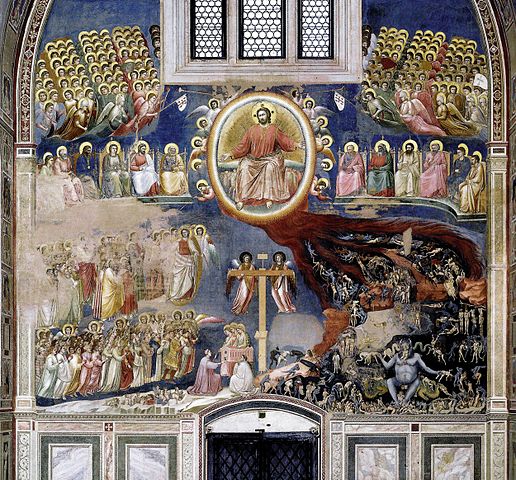 |
| I lifted the picture from Wikipedia for obvious reasons. |
For 15 minutes.
To me, it wasn't that big of a deal because I'm no religious scholar so I mostly just saw "ooh, paintings," but I can imagine that if you were familiar with all the stories depicted and wanted to examine those, or the technique, or the restoration work in detail, you wouldn't have nearly enough time. There's still a lot of restoration work to be done because unfortunately over the years, the adjoining buildings were knocked down and the chapel had its bare brick walls left open to the elements, which took its toll on the frescoes.
My verdict on the whole thing: it's the thing to see, so you probably should, but go in with your expectations set. You're going to feel herded and you won't get as much time as you might want. On the other hand, the fact that 1. the whole thing arose because some guy felt guilty about his family being moneylenders and 2. Giotto painted essentially every square inch of the walls of the entire building, and did it in a spectacular style, make it pretty interesting.
While on the subject of frescoes, the baptistry in the Duomo di Padova (Padua Cathedral) was also decorated in the "more is more" style. These were done by Giusto de' Menabuoi in the 14th century. He's not a household name, but the paintings are pretty incredible. And at the baptistry, you pay your €5 and can stare at it for as long as you want, without any airlocks or associated hassles.
The rest of the Duomo is more recent. As is frequently the case, there were older churches on the site but one burned down and one was destroyed in an earthquake. The one that is currently in place was finished in 1754 and is curiously ordinary-looking outside, and very modern inside.
 |
| Effigy? Wax figure? Mummy? Cryogenically preserved body? I have no idea. |
Anyhow, back to the operating theater. This thing is awesome.
You can't go into it anymore, you can only look at it from below the spot where the body would have been laid. However, it's still amazing to see. This is the oldest operating theater in Europe, and it's hard to tell from the photo, but the space between railings was standing room only and it's a surprisingly tiny room. Students were crammed in there (capacity was 250 people) and apparently fainting was a problem, although since you were so well wedged in, you couldn't really fall anywhere. Very practical.
For the final no-cameras destination, Morgan and I visited St. Anthony's Basilica.
 |
| You can take pictures of the outside. |
 |
| Although you can't take pictures, there are no rules against drawing. |
The tomb is in another part of the church. On the day I was there, it was quite busy. A line of people shuffles past the tomb, and touch it and pray to St. Anthony.
I walked around it, but I didn't touch it as it just didn't seem right. It's not my religion; I am merely an observer. I felt even more strongly about that as I looked around - St. Anthony is the patron saint of lost things and people, and everywhere were photographs of children who are presumably missing.
I can't really think of anything to follow that up with, so I'll just leave it at that. Next time, a day trip to Venice.
,_1376-78,_battistero_di_Padova.jpg/627px-Giusto_de'_menabuoi,_paradiso_(detail),_1376-78,_battistero_di_Padova.jpg)


No comments:
Post a Comment